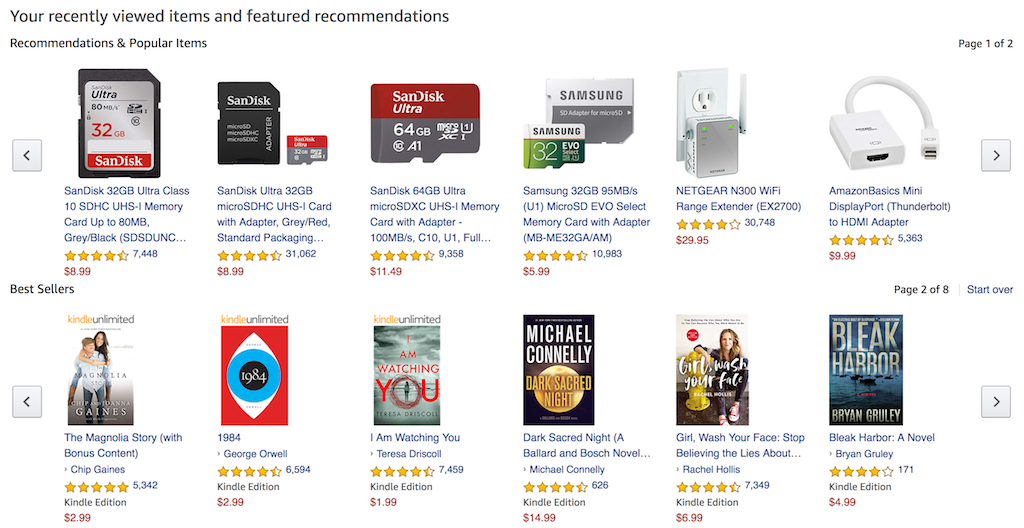
5 Ways Amazon Uses AI in eCommerce to Drive Sales
It’s no wonder why Amazon is a trillion-dollar company today.
After starting as a book-selling platform in 1994, Amazon has become a household name, selling everything under the sun. It is hands-down the biggest online store in the world where millions of people purchase and sell products every day.
Over the years, the eCommerce behemoth has also forayed into digital content (Prime Video, Amazon Studios), gaming (Amazon Luna, Amazon Game Studios), cloud computing (Amazon Web Services), consumer electronics (Alexa, Kindle devices), groceries (Amazon Fresh), publishing (Amazon Publishing), and many more.
Amazon has always tried to keep up with new trends in technology and one such trend that it has adopted whole-heartedly is artificial intelligence (AI).
Being an early adopter of AI and automation, Amazon has a competitive edge over others. The company uses AI to not only improve the efficiency of its business operations but also the customer experience.
Here let’s have a look at how Amazon uses AI in eCommerce to boost its sales and cement its position as a market leader.
5 ways Amazon uses AI to boost sales
1. AI-powered product recommendations
Amazon is an expert in using product recommendations as a marketing tool to boost sales. Whenever you buy something on Amazon or add something to the cart, the website makes a list of recommended purchases using tags like ‘recommended for you’ or ‘customers also bought’.
This works as a powerful nudge for customers to increase the value of their carts. These product recommendations are powered by AI and are personalized for each customer.
The goal is to suggest products that the customer is likely to be interested in. Amazon uses previous customer data like recent purchases, items viewed, or search history to anticipate customer needs and make relevant recommendations.
Amazon’s powerful recommendation engine uses AI to analyze big data and direct users toward buying more items, turning a passive online store into an active sales channel.
Amazon relies on item-to-item collaborative filtering to power its recommendation engine. It collects general information about products as well as data regarding the relationships and dependencies between them.
2. Voice shopping through Alexa

Amazon’s voice assistant Alexa has proven to be one of the biggest success stories for the company in recent years. Although it debuted to mixed reviews in 2014, today, Alexa powers the majority of smart speakers in the world. As per Statista, Amazon’s Alexa holds 26.4% of the global market share for smart speakers.
The voice-powered virtual assistant is capable of allowing customers to find and purchase products by only using voice prompts instead of tapping on a screen.
The technology helps give users a hands-free experience, making online shopping even more effortless than it currently is.
Alexa is also capable of giving users purchase reminders or shopping recommendations.
This trend of voice shopping using AI-powered virtual assistants is another reason why Amazon is at the forefront of technology innovation.
3. Chatbots

Reports suggest that by 2025, 95% of all consumer interactions will be powered by AI. The most common implementation of that will be chatbots, the global market for which is expected to reach $1.25 billion by 2025.
Amazon has made great strides in leveraging chatbot technology to drive sales.
To understand how the technology works, it uses a template ranker where an AI model controls the chatbot’s vocabulary by choosing hand-authored response templates.
These templates are general sentences with dynamic product names, delivery timelines, dates, prices, etc. When a customer shares an input, the AI model updates the preset templates based on the pre-training data.
Amazon uses chatbots to enable two-way communication with customers. It also uses chatbots in other ways like –
- Recording real-time interactions with eCommerce store visitors
- Enabling potential customers to easily browse through the catalog by deploying shopping bots on the storefront
- Answering customers’ FAQs and guiding potential customers to relevant pages on the website
4. Sales forecasting and inventory management
Amazon sells a huge number of products every day while catering to customers in 185 countries. However, with a large volume of products, it is often cost-prohibitive to maintain surplus inventory levels.
While historical patterns can be studied to decide on restocking, the majority of items exhibit variability in demand.
Therefore Amazon leverages AI for product demand forecasting. It uses image recognition, deep learning, and natural language processing to design forecasting models that enable accurate predictions across categories.
Strategically using product forecasting helps Amazon in making the right decisions in product procurement, pricing, and market potential.
Integrating AI in its supply chain has also helped Amazon optimize the supply chain and give customers a delightful shopping experience.
5. Warehouse and delivery optimization
Thanks to AI, the Amazon workers in the fulfillment centers skip manual item scanning, allowing them to store arrived items from manufacturers anywhere on a warehouse shelf and record their location on a computer.
This basically means that Amazon warehouse workers can simply grab an item out of a box, place it on the shelf, and scan the shelf itself.
Moreover, Amazon’s fulfillment centers use automated smart robots to make the process easier.
The company is also a market leader in using AI to optimize product delivery by determining the best route for a package to reach from point A to B.
More recently, Amazon has also started using drones for faster deliveries.
Wrapping up
Among a number of factors that contribute to the success of Amazon, one cannot deny that AI has been crucial in helping Amazon reach where it is today. Becoming an early adopter of this technology has helped Amazon dominate eCommerce over the years.
The company has integrated AI from top to bottom while keeping a constant focus on innovation. This approach has proved to be a catalyst for growth, making Amazon a major AI adopter as well as a market leader.
Here we only discussed a few top use cases of AI in Amazon. But there are many more ways the company uses AI to offer customers a seamless experience.
What about you? How do you plan to use AI in your company? Let us know in the comments.
If you liked reading this article, we would suggest checking these as well –



